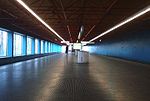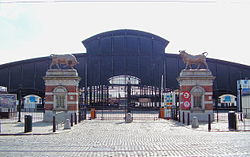Beekkant metro station
1981 establishments in BelgiumBelgian railway station stubsBrussels Metro stubsBrussels metro stationsMolenbeek-Saint-Jean ... and 1 more
Railway stations opened in 1981

Beekkant is a Brussels metro station located in the municipality of Molenbeek-Saint-Jean, in the western part of Brussels (Belgium). It opened on 8 May 1981 as part of the Sainte-Catherine/Sint-Katelijne–Beekkant extension of former line 1, and was for a year, until 6 October 1982, the western terminus of the metro. Following the reorganisation of the Brussels metro on 4 April 2009, it is served by lines 1, 2, 5 and 6. The metro station runs parallel to a railway used for freight trains, and from 2010 again, as a suburban railway line of the future Brussels Regional Express Network (RER/GEN).
Excerpt from the Wikipedia article Beekkant metro station (License: CC BY-SA 3.0, Authors, Images).Beekkant metro station
Rue Dubois-Thorn - Dubois-Thornstraat,
Geographical coordinates (GPS) Address External links Nearby Places Show on map
Geographical coordinates (GPS)
| Latitude | Longitude |
|---|---|
| N 50.853611111111 ° | E 4.3227777777778 ° |
Address
Beekkant
Rue Dubois-Thorn - Dubois-Thornstraat
1080
Belgium
Open on Google Maps










